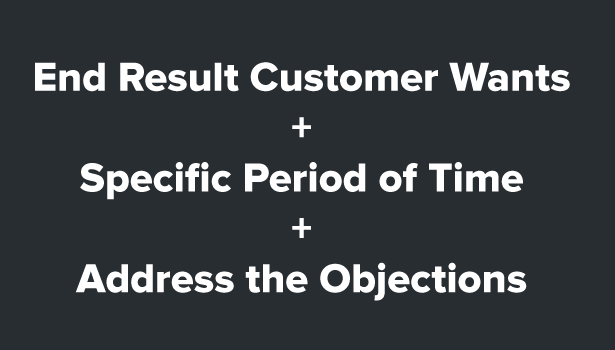3 Copywriting Tips That Will Immediately Increase Your Conversion Rate

How do you grab people’s attention and get them to buy, download, or subscribe?
The answer lies in the words you write.
Beautiful design, compelling content, and a great product are all essential elements for your digital marketing strategy, but copywriting is the thread that holds them all together.
Copywriting is the art and science of selling with the written word.
Whether you’re selling a product, launching an app, or trying to get people to sign up for your webinar or email list, you can increase your conversion rate by following proven, time-tested strategies.
In this article I’m going to give you 3 copywriting strategies that will help you leverage fundamental principles of persuasion to write words that turn random visitors into leads and sales.
1. The Copywriter’s Mindset
Have you ever written an email that said something like, “Good afternoon, my name is John Smith and I work for Acme Technologies. We’re located in San Francisco and provide intelligent cross-channel video solutions for marketers. We offer a cloud-based platform with 50 integrations…”
I received three emails like this last week, and you know what I did? I read the first line and then deleted them.
As soon as someone interacts with your landing page, email, or website, the first thing they want to know is “What are you going to do for me?” and “Is this worth my time?” And if you don’t tell them right away, they’re going to move on to something else. When browsing the web, people are usually:
- Trying to learn something
- Researching a specific topic
- Looking for an answer to their question
- Looking for a solution to a problem
If your copy doesn’t help them with any of that, why would they keep reading?
Many sites start off by focusing on what they do and who they are—not how they can help you. Whether you’re interacting with people online or in person, it’s rude to talk about yourself first. And if you were in their shoes, you wouldn’t read your copy either.
Use this to your advantage. Instead of talking about all of your product’s features and everything it can do, make your copy all about how you can help your prospect.
2. The “Instant-Clarity” Headline
According to the Nielsen Norman Group, “users often leave web pages in 10-20 seconds, but pages with a clear value proposition can hold people’s attention for much longer…”
You could have the best product, service, or app on the market, but if you don’t make it instantly clear why your prospects should care, then they’re going leave.
That's why your headline’s only job is to get your prospect to read the next sentence. Grab their attention right off the bat by appealing to their self-interest. Tell them what you’re going to do for them and what they’re going to get.
This is where the “Instant Clarity” headline comes in. I heard about this formula from Dane Maxwell, who's used it to help grow six successful SaaS businesses, and start a multi-million dollar startup training program. Here’s how it works:

This formula hooks your prospect's attention because it tells them what they’re going to get, when they’re going to get it, and it takes away all the skepticism they might have.
You don’t have to use all three parts of the formula all the time. Using one or two can be just as effective.
Examples of "Instant Clarity" headlines:
- Dominos: “Your pizza in 30 minutes or it’s free”
- Uber: “Get a taxi, private car or rideshare from your mobile phone”
- Quick Sprout: “Give me three months and I'll open the floodgates to consistently profitable traffic for your website”
3. AIDA
AIDA stands for Attention, Interest, Desire, Action, and it’s the most effective copywriting formula I’ve used. Your copy should grab the prospect’s attention, get them interested, make them desire what you’re offering, and compel them to take whatever action you want them to take.
Whether you want your prospect to buy your product, attend your webinar, download your whitepaper or subscribe to your email list, AIDA can help. Here's how it works:
Attention
After you’ve hooked your prospect with an “Instant Clarity” headline, tie your first few paragraphs in with your headline in a natural way. For example, you could:
- Tell an anecdote or a quick story that illustrates your main point
- Share a quote from someone your prospect will recognize as an authority
- Ask a question that piques your prospect’s curiosity and gets them thinking
- Use a metaphor or analogy that indirectly supports your main point
- Paint a picture in their mind’s eye to engage their imagination
- Cite a statistic that shocks your prospect
Interest
So, once you have their attention, the next thing to do is to get them interested.
In his book The Boron Letters, legendary copywriter Gary Halbert gives the example of selling Maui real estate. He says that the best way to build interest is to feed your prospects interesting facts like:
- How much money is to be made by investing in Maui real estate
- How much sand (in cubic tons) is on the beach
- Why this is one of the best beach front investment opportunities in Maui
- How many beautiful people there are on the beach
- The specific kinds of fish you can catch right off the beach
- And on and on
You might not be selling Maui real estate, but but come up with a list of interesting facts about your own offering.
Desire
Now that you’ve gotten your prospect interested, it’s time to start creating desire. How do you do that? Well, you describe the benefits your prospect will get if they buy your product, download your app, or subscribe to your list.
Paint a picture in their mind’s eye of what it would be like to have those benefits. If your product helps them save time, list out all of the benefits of having more time. For example, some benefits of having more money are:
- Vacations
- Leisure time
- Big house
- New car
- Peace of mind
Action
Now that you’ve gotten their attention, sparked their interest, and created desire, the next step is to get them to take action.
When you tell your prospects what action you want them to take, be specific and clear. Don’t assume anything is obvious. Take them by the hand and lead them exactly where you want them to go, and tell them exactly what you want them to do.
For example, if you want them to sign up for your webinar, you could say:
“If you want to learn 3 unconventional strategies that will dramatically increase your conversion rate, enter your email address below and click “Sign Up Now!” to reserve your spot. You’ll receive an email confirming your registration, and we’ll send another email the day before the webinar to remind you."
Conclusion
There are literally hundreds of copywriting strategies that can help you increase your conversions. For example, create a curiosity gap, be clear and concise, use benefits (not features), make it scannable, etc.
But if you apply these three copywriting strategies, you’ll have the tools you need to write copy that converts random traffic into leads and sales. Your prospects will easily be able to find what they’re looking for. And if you’re solving a real problem for them, they’ll be happy to do business with you.
As a result, more people are going to buy your product, attend your webinar, download your white paper, sign up for your email list, and do whatever else you ask them to do.
Question: What’s the one copywriting strategy that’s increased your conversions the most? Leave a comment and let us know!
Insights that drive innovation
Get our best human insight resources delivered right to your inbox every month. As a bonus, we'll send you our latest industry report: When business is human, insights drive innovation.






